As more families embrace homeschooling as a flexible and personalized educational option, the interest in teaching foreign languages like Spanish at an early age continues to grow. Finding a homeschool curriculum that includes interactive and fun activities for Spanish for homeschool elementary students though can be challenging.
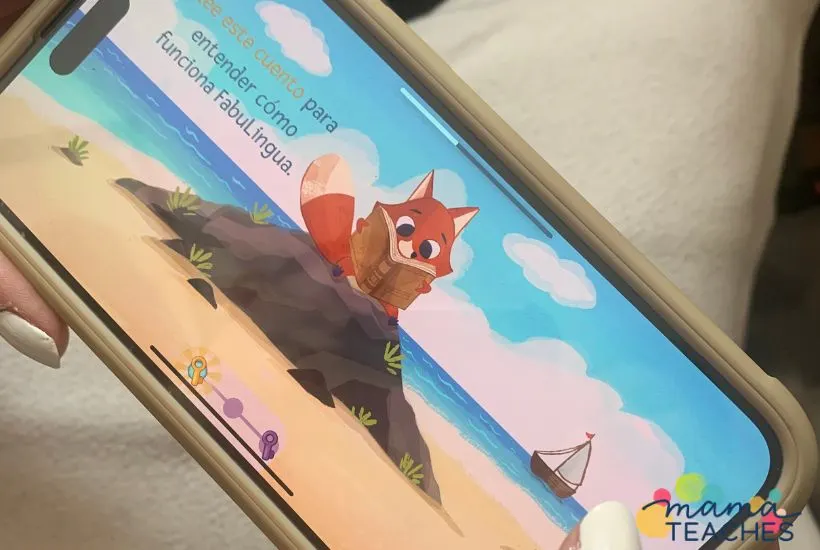
I was compensated for my time to write this post. All opinions are my own. This post contains affiliate links.
For homeschooling parents seeking to introduce their elementary, kindergarten, and preschool students to the beauty of the Spanish language, it’s essential to adopt effective and engaging approaches that cater to young learners’ developmental needs.
In this article, we present five invaluable tips specifically tailored to make learning Spanish for homeschool elementary students a joyful and rewarding experience.
Whether you’re just beginning your language journey or looking to enhance your existing Spanish curriculum, these tips will help unlock the full potential of your young learners as they embark on their exciting language-learning adventure.
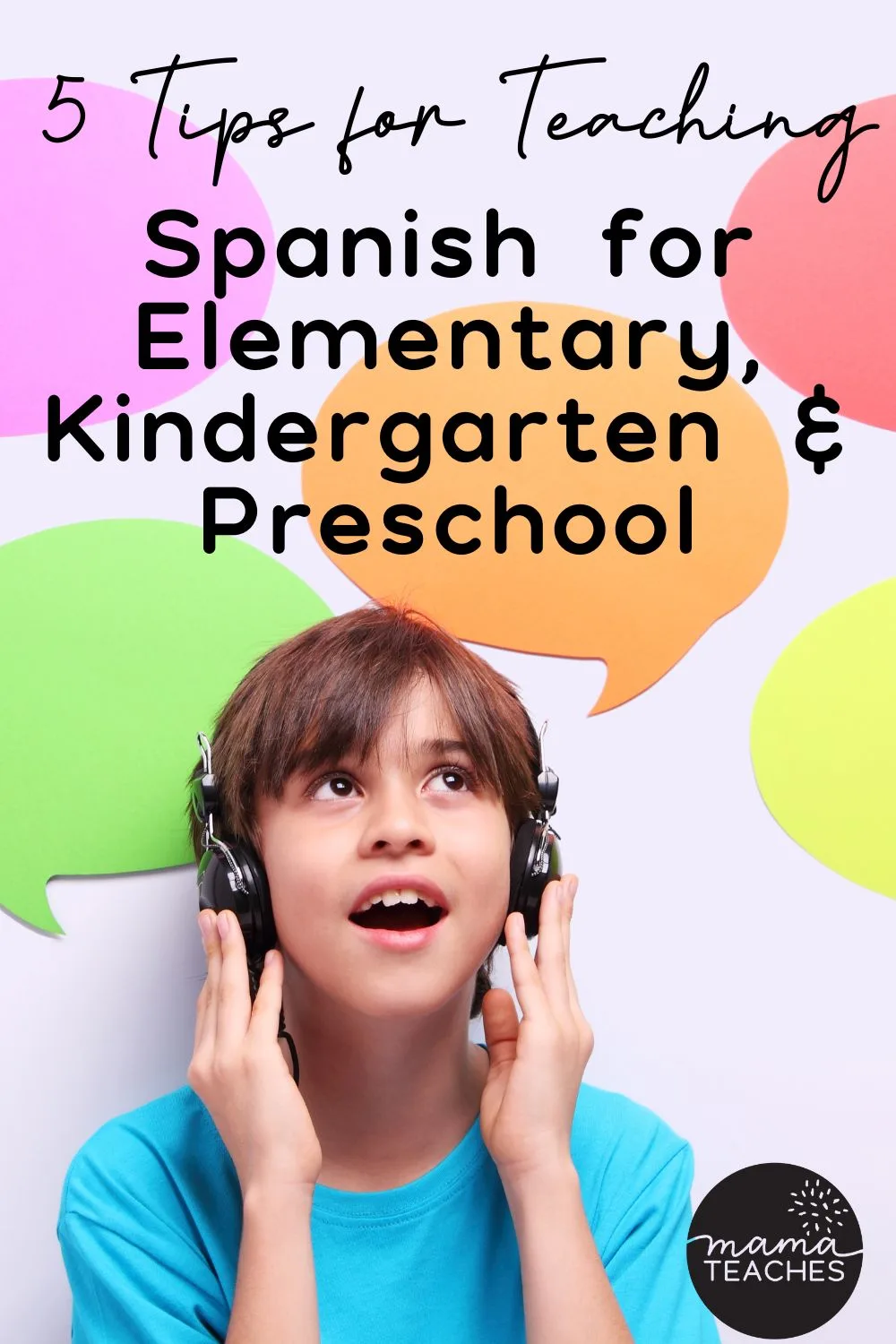
Benefits of Learning a Second Language at an Early Age
More Gray & White Matter = Better Memory
Bilingual children’s brains have been found to exhibit more grey and white matter compared to monolingual children, and this phenomenon holds significant importance in the learning process.
Grey matter is responsible for processing information, while white matter facilitates communication between different brain regions.
The increased volume of grey matter in bilingual brains is linked to their heightened ability to handle multiple languages and the constant need to differentiate between them.
This enhanced processing capacity enables bilingual children to switch between languages effortlessly, enhancing their cognitive flexibility and executive function skills.
Additionally, the greater volume of white matter promotes efficient communication across brain regions, enabling better integration and transfer of knowledge.
These structural advantages in bilingual brains translate into improved cognitive abilities, language processing skills, and overall learning capabilities, providing a strong foundation for academic success and cognitive development throughout their lives.
Enhanced Focus & Attention Span
Learning a second language at a young age has been shown to have a profound impact on focus and attention spans.
Young children’s brains are highly receptive to language acquisition, and the process of learning a new language involves heightened cognitive engagement.
As they work to distinguish between two linguistic systems, they develop greater cognitive flexibility and mental agility.
This enhanced cognitive ability transfers to other areas of their lives, leading to improved attention spans and better concentration in various tasks.
Furthermore, the regular practice of switching between languages stimulates the brain’s executive functions, strengthening working memory and cognitive control.
As a result, bilingual children tend to exhibit improved focus, attention to detail, and the ability to maintain concentration for more extended periods, all of which contribute to their academic achievements and overall cognitive development.
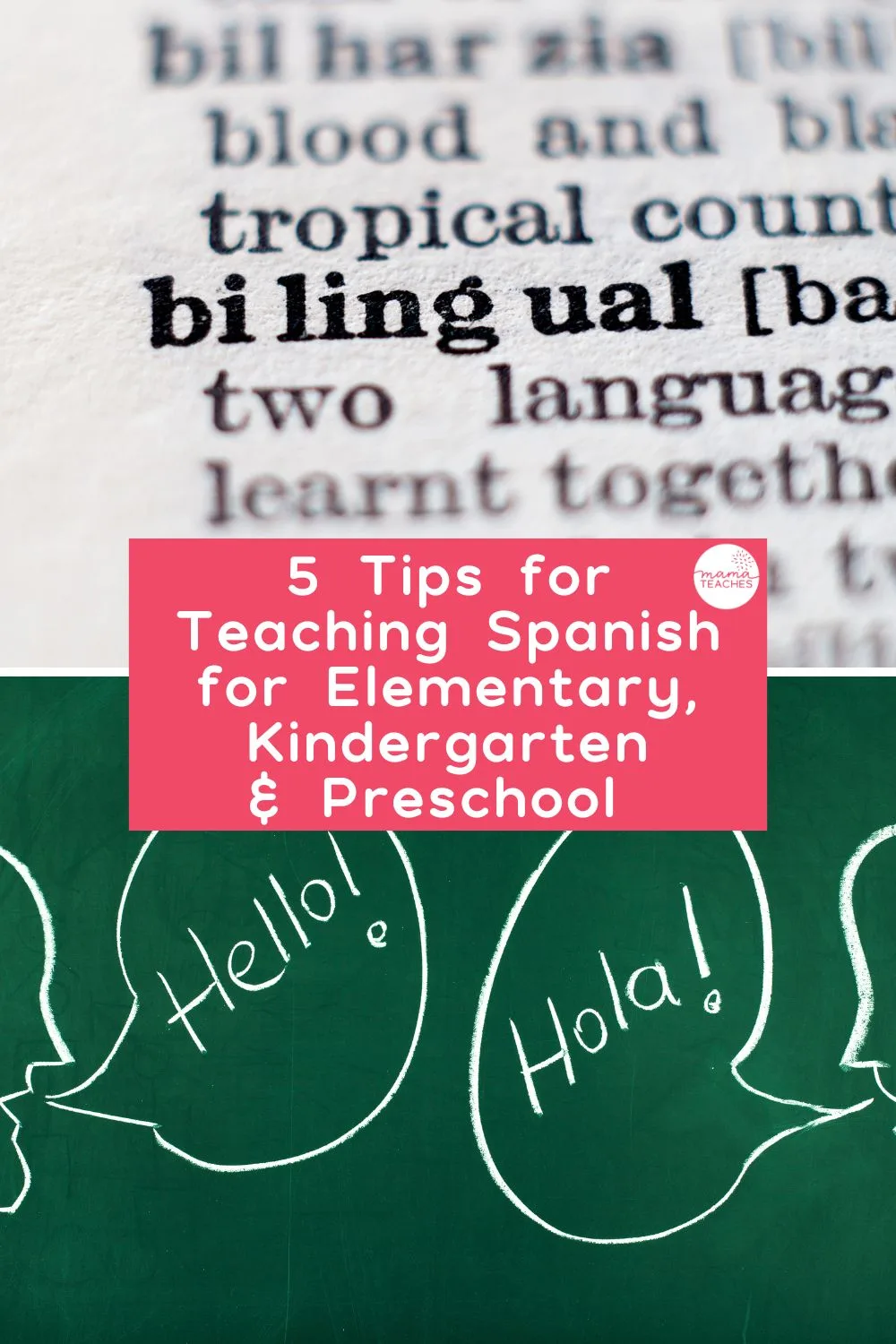
Enhanced Cognition & Executive Functioning
Learning a second language at a young age has been found to significantly boost cognition and executive functioning skills.
That’s why learning Spanish for homeschool elementary students is such a great addition to any homeschooling curriculum!
As young brains absorb and process the complexities of a new language, they develop heightened cognitive abilities.
Bilingual children often display enhanced problem-solving skills, greater creativity, and improved memory retention.
The constant need to switch between languages also strengthens their executive functioning skills, such as cognitive flexibility, working memory, and self-control.
These skills are vital for effective decision-making, planning, and organizing information.
Moreover, the process of mastering two languages promotes a deeper understanding of language structures and patterns, which sharpens analytical and critical thinking abilities.
Overall, early exposure to a second language lays a solid foundation for improved cognitive function, benefiting children academically and setting them up for success in various aspects of life.
Enhanced Empathy
Learning a second language at a young age can foster enhanced empathy in children.
When children are exposed to and engage with different languages, they are also exposed to diverse cultures, perspectives, and ways of life.
This exposure promotes a broader understanding and appreciation of cultural diversity, leading to increased empathy and compassion toward others.
Bilingual children often develop a more open-minded and accepting worldview as they learn to navigate different linguistic and cultural contexts.
Furthermore, the process of language learning itself involves listening, understanding, and empathizing with speakers of the second language, which cultivates empathetic communication skills.
These early experiences with multiple languages create a strong foundation for children to become empathetic and culturally sensitive individuals, facilitating positive social interactions and promoting a sense of global interconnectedness as they grow older.
Better Pronunciation
Learning a second language at a young age can lead to significantly improved pronunciation of the language.
Young children have a remarkable ability to imitate sounds and accents, making them adept at mimicking native speakers’ pronunciation.
As they are exposed to the language early on, their developing brains are more receptive to the phonetic nuances and intonation patterns of the new language.
Through consistent practice and immersion, they refine their pronunciation skills and develop a more authentic accent.
The brain’s plasticity during early childhood allows for seamless integration of these linguistic nuances, ensuring that the correct sounds and speech patterns become ingrained in their language skills.
This advantage in mastering pronunciation sets the foundation for more natural communication and a higher level of language fluency as they continue their language learning journey.
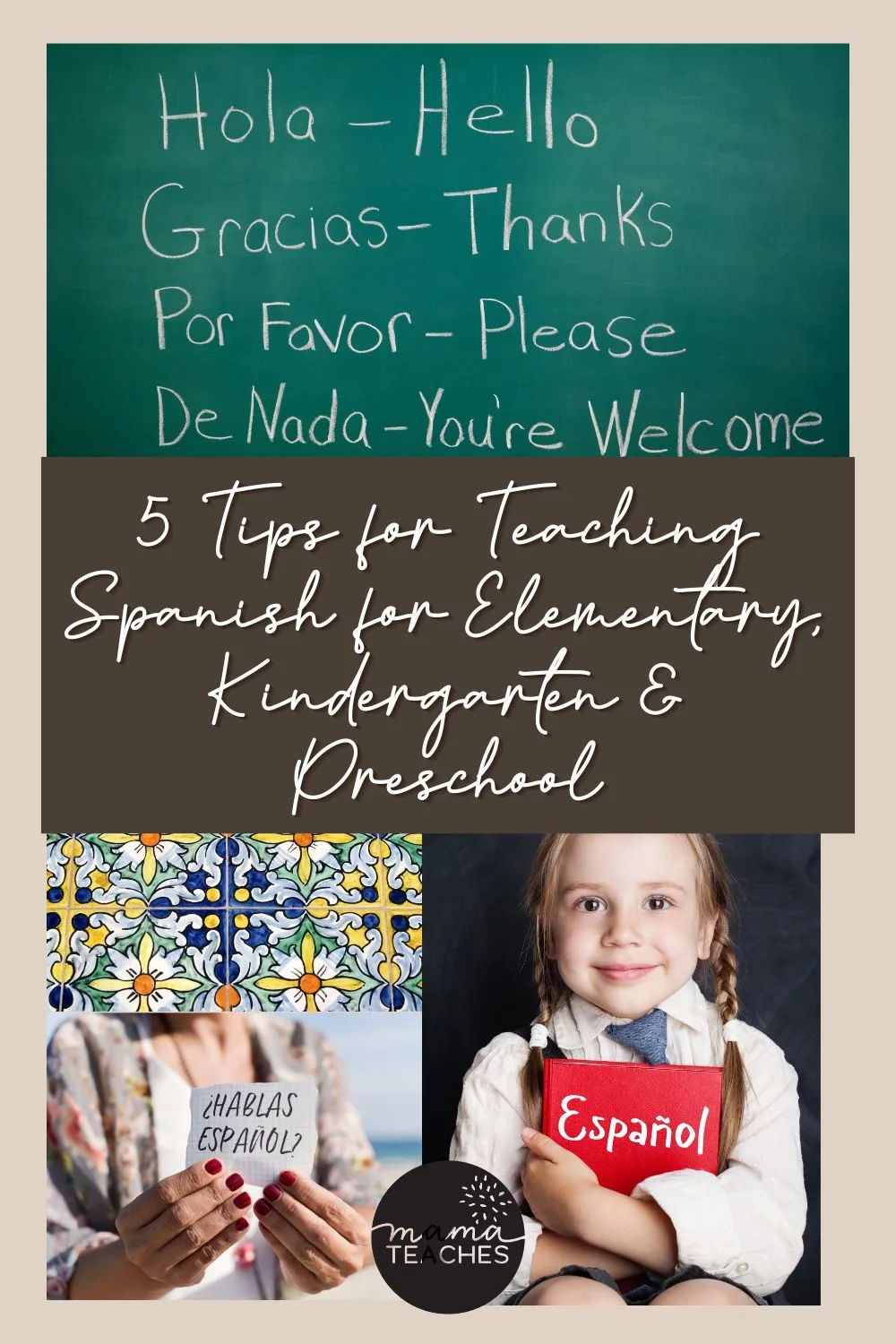
How to Teach Spanish for Preschool & Kindergarten Homeschool Students
Focus on Comprehensible Input
One of the most effective strategies for language learning is to focus on language input through reading and listening.
To make the language more comprehensible, you can use interactive techniques such as acting out scenes, drawing visual representations, or translating.
A great way to access a variety of Spanish books is by visiting the library or purchasing them online from platforms like Amazon or even eBay.
Reading to Your Child in Spanish
When reading stories in Spanish to your child, it is important to engage them by acting out the story, translating unfamiliar words, and discussing the events on each page.
The main goal is to ensure that your child truly understands what is happening in the story.
As you continue to read these stories, your child will become more familiar with the language, and you will gradually need to do less acting or explaining since they will already grasp the story’s content.
If you are not a native Spanish speaker, don’t worry!
Reading your child beginner-level Spanish stories can also help improve your own Spanish skills.
Don’t be concerned about your accent; as long as your child is exposed to native Spanish speakers in other ways, they will be fine.
Spanish Storytime
However, if you feel uncomfortable reading or prefer not to, consider attending bilingual story times at public libraries.
Storytellers often excel at acting out stories and delivering comprehensible input.
Turn to YouTube
You can also find comprehensible input stories on YouTube, but most of them are designed for adults.
For children-specific comprehensible input stories, check out channels like Calico, BookBox Spanish, Muzzy Spanish, and FabuLingua’s free YouTube channel.
These resources provide comprehensible input without subtitles, which is crucial for pre-readers.
Spanish Podcasts
Podcasts can be a powerful source of language input, especially when accompanied by a parent reading along or using digital stories with word-by-word highlighting.
These tools effectively show beginners where each word starts and ends, even for pre-readers.
Once children reach a certain level of Spanish proficiency, they can graduate to listening-only input, such as beginner-level podcasts like ‘Eat Your Spanish’ for more comprehensible input.
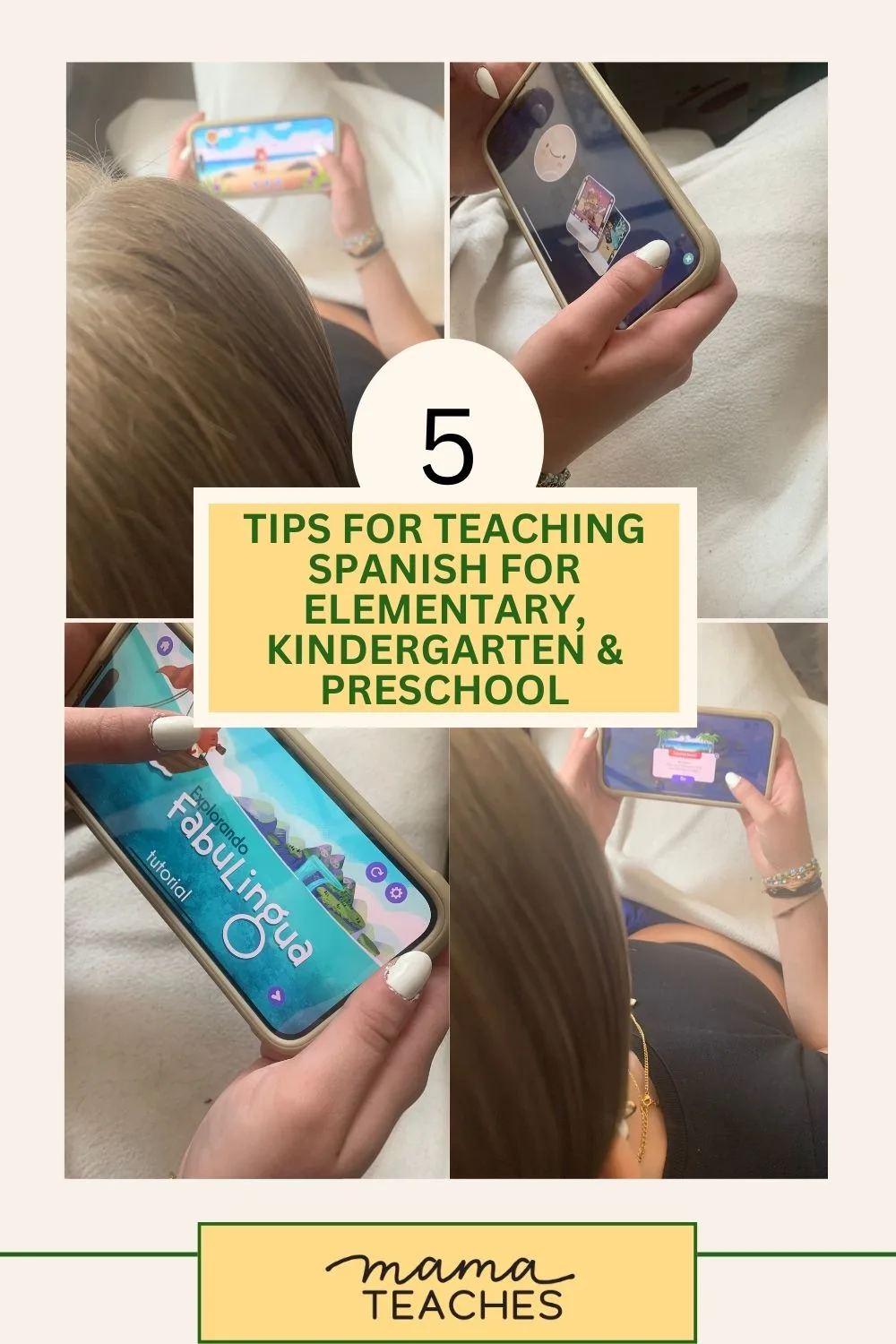
Learn Through Music
Music can also serve as a great source of comprehensible input, especially when specifically created for second language learners.
Look for resources like Super Simple Español, Rockalingua, and Mi Casa Es Tu Casa, which provide engaging music with acting to make the words more comprehensible.
Spanish Fairy Tales
Classic fairy tales can be useful because children already know and understand them.
By watching these tales in Spanish, they can have a general idea of what is happening.
Recommended resources for this approach include GBP Salsa and The Spanish Experiment.
FabuLingua App
Consider downloading the FabuLingua app, which offers high-quality, interactive, and compelling comprehensible input.
FabuLingua specializes in converting children’s stories into comprehensible input and provides a patent-pending platform for language learning.
Avoid Stress or Boredom! It’s Crucial That It’s Fun, Compelling, and Engaging!
As a parent, you are the best judge of what your child finds stressful or boring.
Pay attention to any signs they may give and avoid forcing them to complete language courses that they find uninteresting or overwhelming.
Make It Story-Based
It is widely recognized that reading is the most effective method for expanding a child’s vocabulary in any language, including English.
And guess what? It is equally powerful when it comes to learning Spanish!
Respect the Silent Period
Don’t ask too much too early. There is going to be a time when your child just needs to absorb the language before they can repeat it.
Respect that time and keep learning fun for them.
Don’t Focus on Grammar in the First Few Years
Just as a sturdy building requires a strong foundation before adding the finishing touches, grammar finds its place in language learning after extensive exposure to comprehensible input.
Consider how we only delve into the intricacies of grammar in our native language once we have a solid grasp of it from comprehensible input.
Think of grammar as the final brushstrokes on a painting.
Without the carefully constructed canvas and vibrant colors already there, the brushstrokes would simply be a chaotic mess.
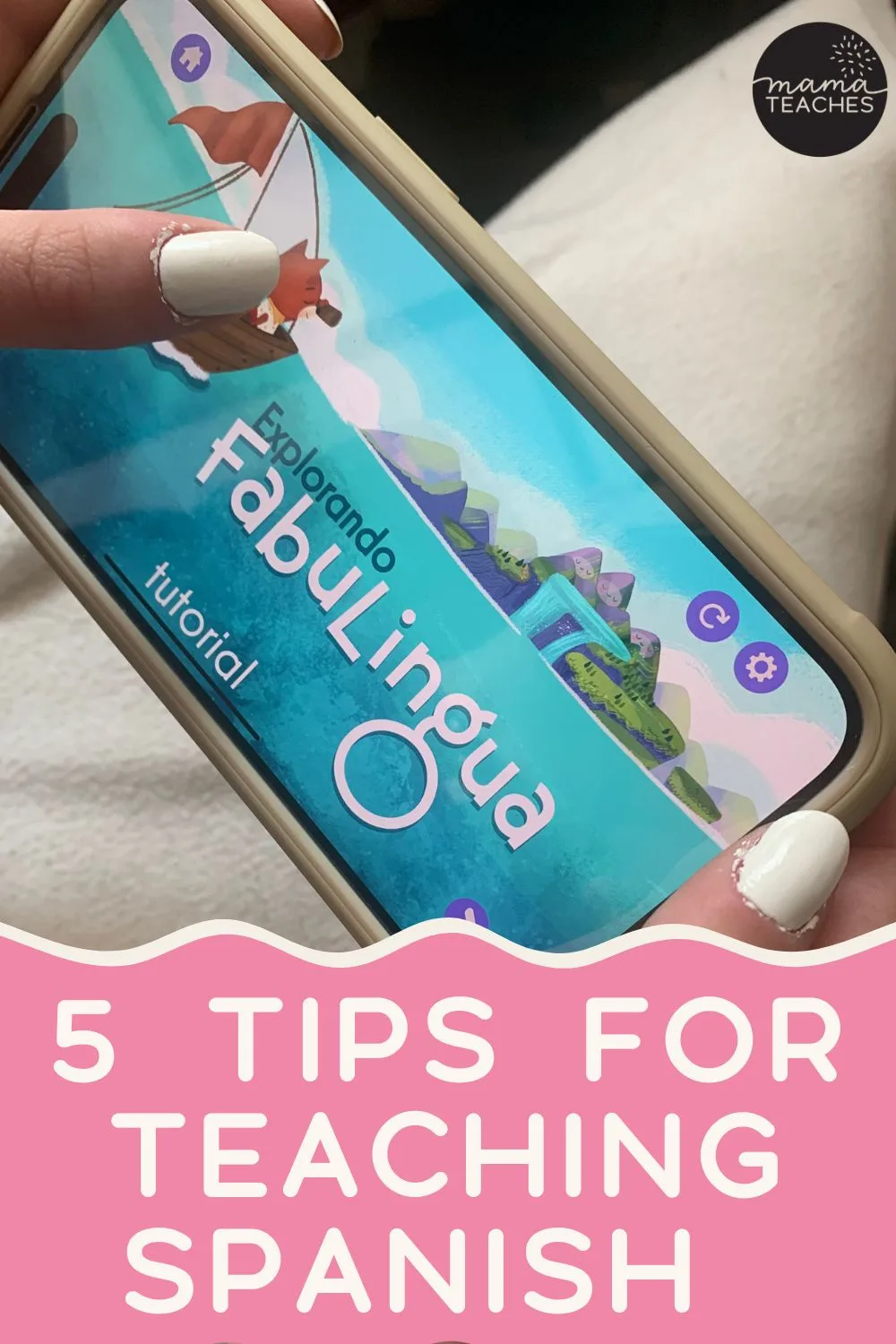
We Love FabuLingua for Preschool & Kindergarten!
FabuLingua is an app that combines all the elements mentioned above to create a fun and engaging language learning experience for kids!
Unlike many YouTube stories that lack interactivity, FabuLingua offers interactive and immersive children’s stories.
While other language learning apps or online classes for this age group may be superficial and resemble flashcards more than effective teaching tools, FabuLingua stands out by delivering comprehensible input through its unique and patented method.
The stories take place in an exciting mobile game where kids become explorers on an island, unlocking new locations as they progress.
Each story follows a Learning Path.
Magical Translations
For young pre-readers, the primary focus is on the “Magical Translations” mode, which delivers comprehensible input and is the most important mode of learning.
In this mode, children benefit from hearing the stories read by native Spanish speakers and easily understanding them.
They also interact with various elements on each page, learning their meaning within the context of the illustration.
Repetition is key, so engaging in this mode multiple times is crucial.
As a reward for completing the story, they can enjoy the adorable dances performed by the characters.
Matching Game
Some pre-readers may be ready to move to the next step on the Learning Path: playing the Matching Game.
This game requires matching images from the story with their corresponding Spanish names.
Pre-readers can tap the Spanish names to hear them pronounced in Spanish and then move the corresponding picture into the designated circle.
If needed, they can tap the picture to hear its name in English.
The game changes the words and pictures each time, providing a fresh challenge with every playthrough.
CopyCat
The CopyCat mode is popular among pre-readers, as they get to imitate the narrator’s voice and hear their own voices played back alongside the narrator’s.
This mode doesn’t require reading skills; instead, it helps children develop native-like pronunciation by attuning to native speech.
Scrambled Syllables
The second game, Scrambled Syllables, involves moving syllables around to form words while hearing them pronounced.
By tapping on the drawing, children can hear the complete word in Spanish.
This game is beneficial for pronunciation practice and introduces the visual discrimination skills necessary for reading.
Spanish Only Story
In the third mode, children listen to the story again, this time in Spanish only. This indicates that they have a good understanding of the story.
Listening to it repeatedly reinforces their comprehension.
Subsequent modes and games are more suitable for readers.
Parents can choose to skip these or go back to previous modes, or they can model how to navigate the more challenging modes and read the story aloud while playing advanced games.
Please note that very young children may require guidance from parents to navigate the app and access character locations and stories within the game.
However, once they become familiar with the app, they will soon be able to use FabuLingua independently.
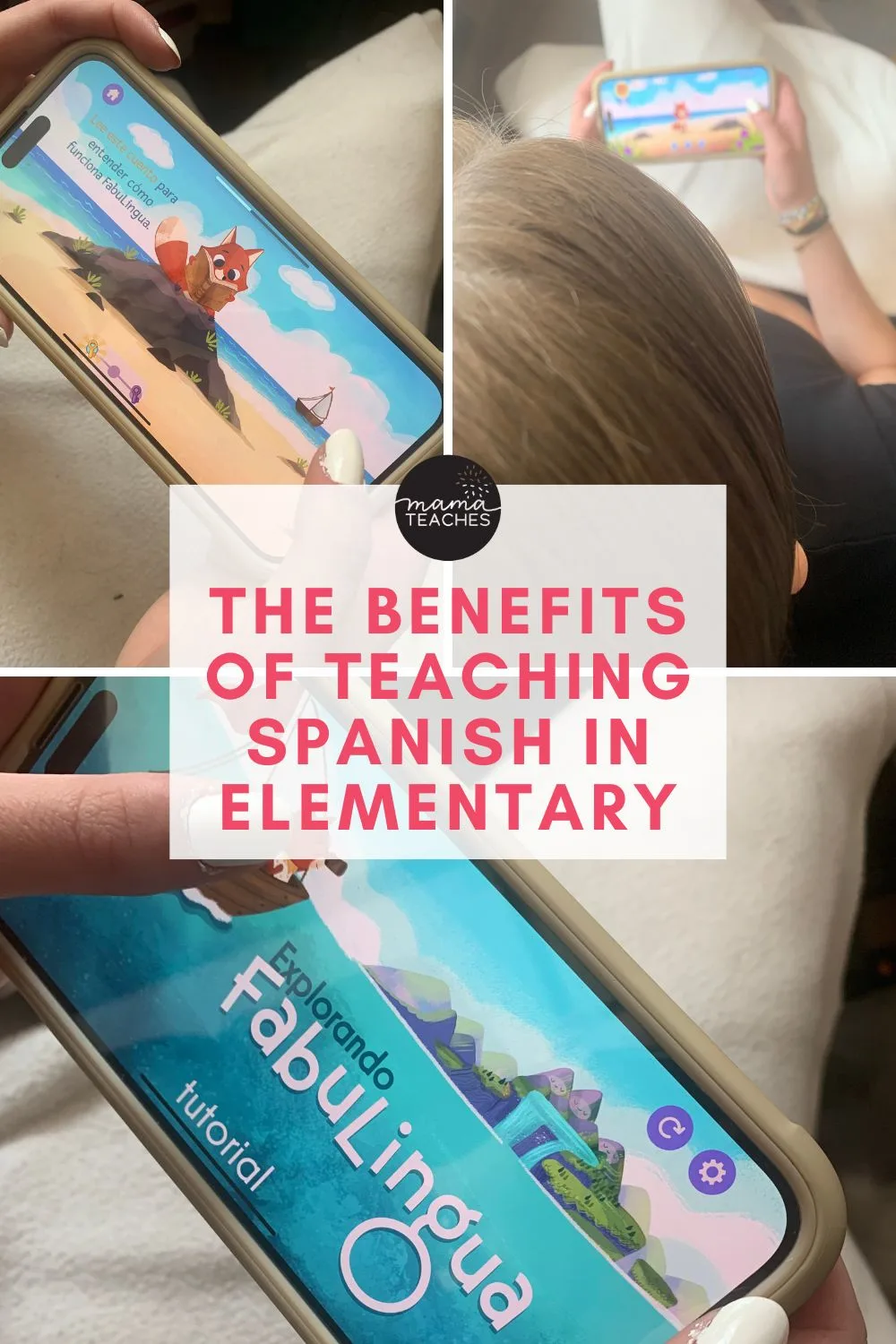
How to Teach Spanish for Homeschool Elementary Students
The Above Principles Apply Equally to Elementary Students
According to research on second language acquisition, it has been found that certain elements are vital for individuals of all ages when learning a language.
These elements apply from early childhood through elementary, middle school, and beyond.
Just as with preschool and kindergarten students, comprehensible input, which involves providing learners with a significant amount of language that they can understand, is key.
This input should not be overwhelming or monotonous, and it is important to respect the silent period during which learners may prefer to listen and observe rather than actively participate.
Additionally, the content and materials used for language learning should be compelling and engaging to the learner.
It is worth noting that what is captivating and interesting to a young child may differ from what engages an older child or an adult.
Therefore, it is important to consider the age and interests of the learner when designing language learning experiences.
Spanish for homeschool elementary students may look vastly different than what a preschooler or high schooler may experience.
Focus on Comprehensible Input
To find sources of CI for Spanish for homeschool elementary students, you can refer to the list provided above in the preschool and kindergarten section.
Many of the materials mentioned for younger age groups will still be suitable for 1st, 2nd, and 3rd graders, although some may not be as interesting for 4th and 5th graders.
The key is to find CI resources that are engaging and appealing to your child at their current age.
This may require some experimentation to see which options your child finds interesting.
It’s important to note that while certain materials may seem too “babyish” for them in English, they may actually be suitable and effective for them in Spanish.
In fact, if a particular input appears easy, it can help lower their affective filter and make the learning process more effective.
Most of the YouTube channels mentioned above will work well for students in 1st, 2nd, and 3rd grades as well.
However, for older elementary school kids in 4th and 5th grades who may have outgrown those children’s CI stories, you can try other stories available on YouTube.
While these stories are not specifically designed for kids, like “Spanish with Alma,” they are generally suitable for older elementary students.
Remember to consider your child’s interests and preferences when selecting CI resources, as this will contribute to their motivation and engagement in the language learning process.
Avoid Stress or Boredom!
Similar to what was mentioned for the younger age group, it is crucial to understand the significance of managing stress and boredom in language learning.
Stress and boredom can have a detrimental effect on the language acquisition process.
However, it is important to recognize that the manifestations of stress and boredom may vary for the older age group, requiring a different approach to identifying the signs.
Make It Story-Based
Reading is the most effective method for enhancing a child’s English vocabulary at any age.
Moreover, researchers have discovered that it holds similar power when it comes to learning Spanish!
Compared to using flashcards, learning vocabulary through reading provides a much more impactful approach, as it allows learners to grasp words within their natural context.
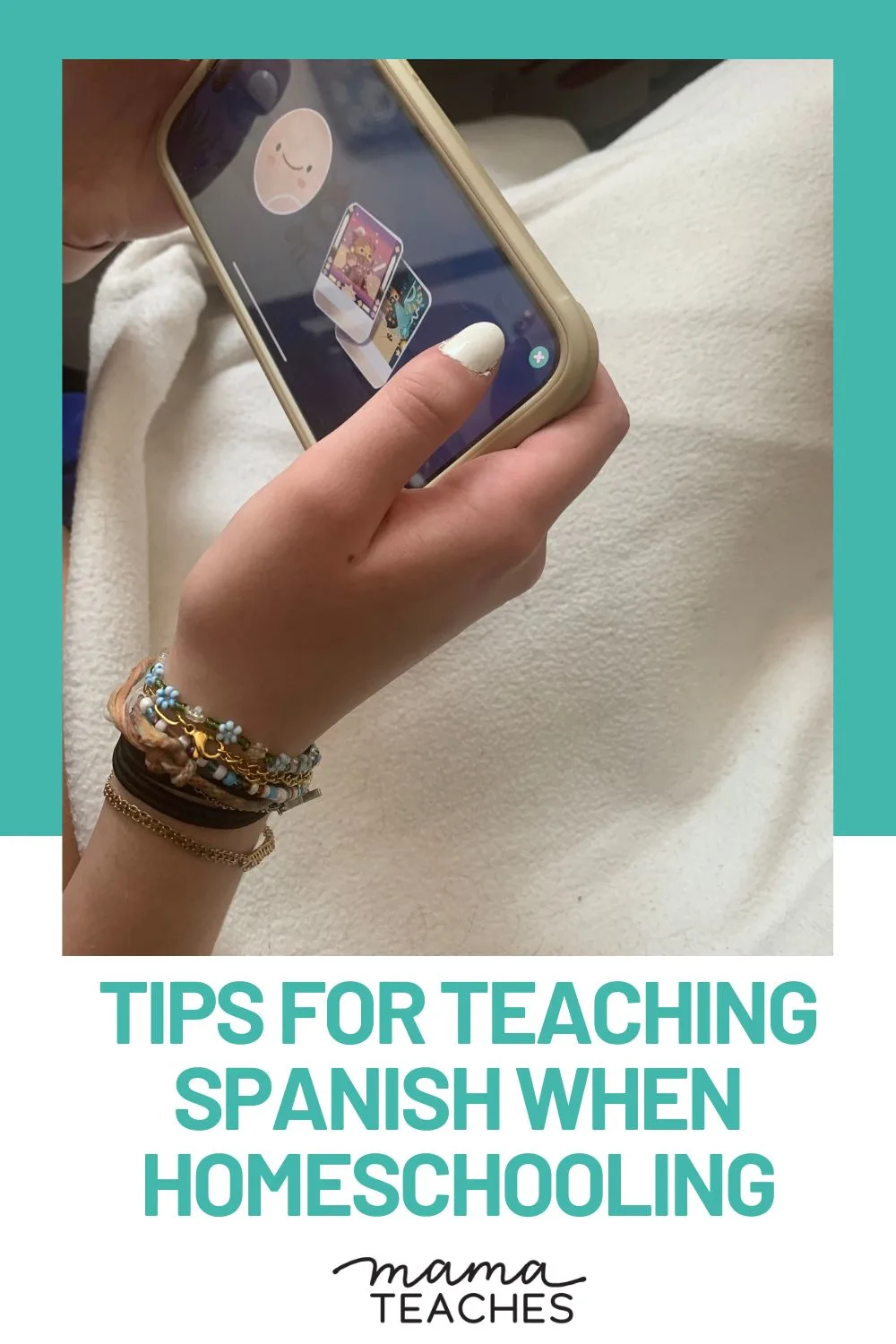
Respect the Silent Period
The silent period is a natural phenomenon that occurs at any age, and it’s crucial to acknowledge and respect it as an integral part of the language-learning process.
While it’s acceptable to encourage kids to mimic and imitate, pushing them to create original sentences too soon in their journey can cause undue stress and turn language learning into a challenging struggle (and that’s not a winning approach!).
Netflix Can Also Help
To immerse yourself more deeply in the language, consider utilizing Netflix as an additional tool.
The advantage of Netflix over YouTube lies in the positive approach of offering a certain amount of choice, which is a successful strategy in parenting.
With Netflix, you can create a profile in the target language, apply age-appropriate filters, and allow your child to explore content from that profile (all in Spanish!).
This is far more preferable than having to constantly monitor their YouTube viewing, where the algorithm may stop showing Spanish content once the language is changed to English.
To avoid this, keep English shows restricted to other profiles.
Empower your child to make choices by letting them select which series to watch, as this autonomy is crucial for maintaining their motivation (within appropriate age boundaries, of course!).
To start, use English subtitles, and after a few months, switch to Spanish subtitles.
Over time, you can even remove the subtitles entirely.
Watching a series is beneficial as it offers clear context and follows a single storyline at a manageable pace.
While ideally, you should opt for programs originally created in Spanish, translated content is acceptable, especially as it can be challenging to find Spanish content specifically tailored for kids.
Don’t Focus on Explicit Grammar Instruction
The CI (Comprehensible Input) approach allows you to absorb a significant amount of grammar implicitly and subconsciously.
While explicit grammar lessons have their place, they should come much later, after years of being exposed to ample comprehensible input.
Introducing explicit grammar too early in the language learning process and with excessive intensity is likely to dampen the joy of learning a new language and may even lead to giving up on the language altogether.
Moreover, it can make learners overly self-conscious about making grammatical errors, leading to paralysis in communication.
Learners may become hesitant to express themselves, fearing mistakes, and this can hinder their ability to communicate effectively.
Therefore, it’s essential to prioritize a gradual and natural approach, allowing learners to absorb grammar implicitly through exposure to comprehensible input before delving into explicit grammar lessons.
This way, language learning becomes a more enjoyable and sustainable journey.
Online Classes or Courses
If your budget allows, exploring online tutoring in Spanish can be a valuable option.
However, it’s important to keep in mind that virtual tutoring can still add a significant amount to your yearly expenses.
When seeking a tutor, prioritize finding someone who embraces the best practice of CI (Comprehensible Input) teaching and avoids the outdated “drill and kill” method focused on grammar and vocabulary memorization.
Scientific research has demonstrated that this approach does not lead to true language acquisition; instead, it tends to be more effective for test-taking skills, and the learned material is quickly forgotten.
Opting for a tutor who understands and implements CI will ensure a more meaningful and lasting language learning experience.
Spanish Learning Apps
Most Spanish learning apps available are primarily flashcard apps intended for vocabulary drilling rather than following a CI (Comprehensible Input) approach.
While some parents may choose to try these apps, they tend to offer limited engagement for younger elementary kids.
However, 5th and 6th graders might find some level of engagement with apps like DuoLingo.
For younger Elementary kids seeking a more engaging experience, flashcard apps like Gus on the Go and The Spanish School Bus are worth considering.
Yet, among all the apps we’ve explored, the FabuLingua App stands out as the only one explicitly designed around CI for children.
This app not only offers the ease and convenience of a typical app but also focuses on providing comprehensible input, making it a more effective and enjoyable tool for learning Spanish.
Simplify Spanish Homeschooling for Elementary Students with FabuLingua!
In our quest for Spanish for homeschool elementary students experience, the FabuLingua platform has proven to be the most convenient and effective solution for teaching Spanish to Elementary aged children up to 6th grade.
It serves as a comprehensive one-stop shop, simplifying the entire language-learning process for our family.
What sets FabuLingua apart is its focus on acquiring language naturally and subconsciously, utilizing a patented method grounded in modern language learning science.
The platform’s depth of expertise goes beyond that of a simple app, offering a beautiful pronunciation experience and fostering reading and spelling skills.
The platform’s appeal spans across age groups, as it caters to both pre-schoolers and Kindergarteners while also working remarkably well for Spanish for homeschool elementary aged children.
The interactive stories take place in a captivating mobile game set on the island of FabuLingua, with new locations unlocking as progress is made.
Reading stories earns keys, which can be utilized in a Card Battler, reminiscent of Pokemon, and a Magic Sticker Book, creating a strategic gaming experience.
This feature engages older elementary kids on multiple levels, keeping them learning for extended periods.
While the gaming aspect may not appeal as much to the youngest learners, it keeps older children motivated through the more challenging parts of each story’s Learning Path.
This strategic engagement encourages them to tackle linguistic skills such as spelling, reading, and some grammatical concepts in addition to comprehension and native-like pronunciation.
As children progress to the highest locations on FabuLingua island, they encounter intermediate-level stories that truly enhance and stretch their Spanish language abilities.
FabuLingua’s effectiveness in nurturing proficiency towards an intermediate level makes it a standout choice for Elementary aged learners.
Try Homeschooling with FabuLingua for a Month for FREE!
Use the code “MT1MONTHFREE” to get a month for free! This is a great value at $69.99 for an annual subscription that gives you 6 profiles!
That means all of your kids can be learning Spanish at the same time!
